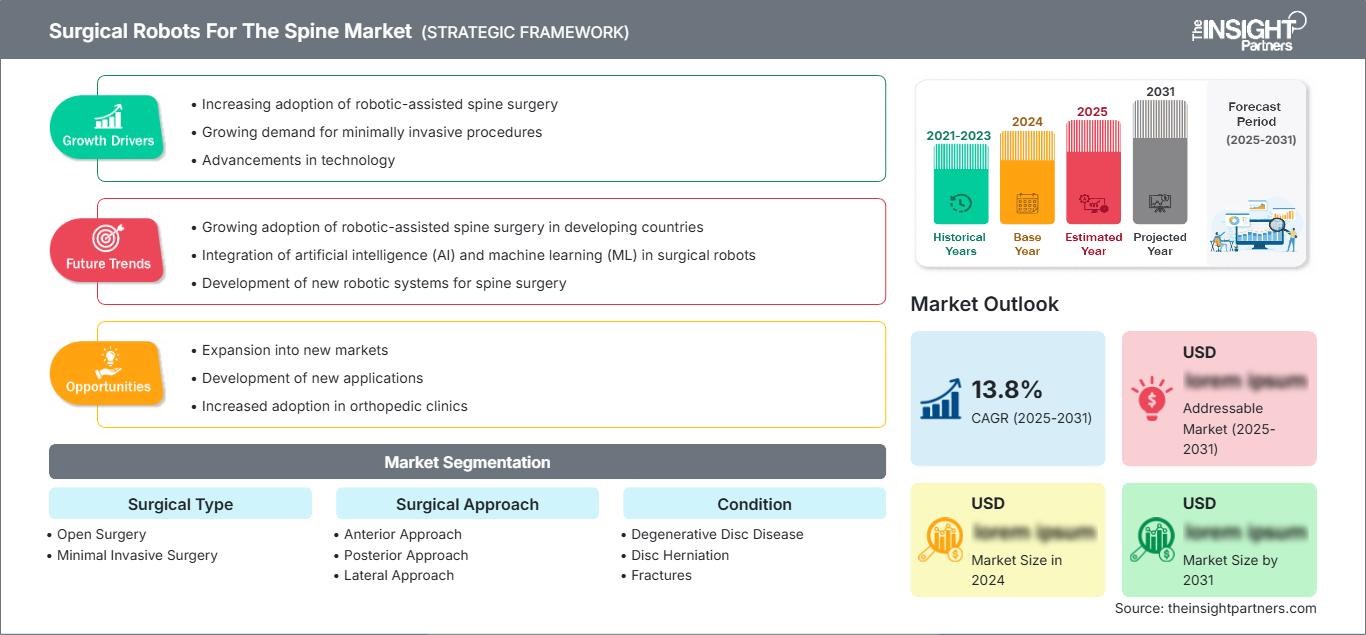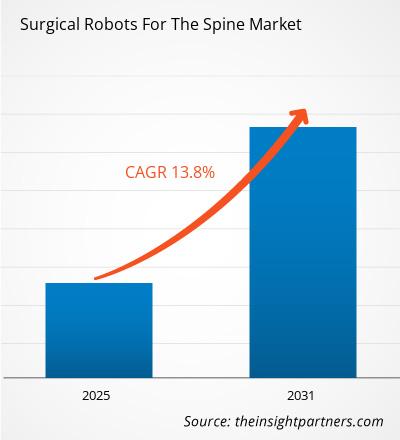Si prevede che il mercato dei robot chirurgici per la colonna vertebrale raggiungerà i 744,84 milioni di dollari entro il 2031. Si prevede che il mercato registrerà un CAGR del 13,4% nel periodo 2025-2031.
Il rapporto è segmentato per tipo chirurgico (chirurgia aperta e chirurgia mininvasiva), approccio chirurgico (approccio anteriore, approccio posteriore e approccio laterale), condizione (malattia degenerativa del disco, ernia del disco, fratture, instabilità, deformità, tumori, infezioni); applicazioni (laminectomia, fusione spinale, sostituzione artificiale del disco, discectomia cervicale anteriore, forminatomia, impianto interlaminare, lisi epidurale delle aderenze, vetrebroplastica percutanea, mal di schiena cronico, laminotomia, OLLIF, stenosi spinale); Utenti finali (ospedali e cliniche, centri di chirurgia spinale, centri di neurochirurgia)
Scopo del rapporto
Il rapporto "Robot chirurgici per il mercato della colonna vertebrale" di The Insight Partners mira a descrivere il panorama attuale e la crescita futura, i principali fattori trainanti, le sfide e le opportunità. Ciò fornirà spunti a vari stakeholder aziendali, come:
- Fornitori/produttori di tecnologia: per comprendere le dinamiche di mercato in evoluzione e conoscere le potenziali opportunità di crescita, consentendo loro di prendere decisioni strategiche informate.
- Investitori: per condurre un'analisi completa delle tendenze in merito al tasso di crescita del mercato, alle proiezioni finanziarie di mercato e alle opportunità esistenti lungo la catena del valore.
- Enti di regolamentazione: per regolamentare le politiche e le attività di controllo sul mercato con l'obiettivo di ridurre al minimo gli abusi, preservare la fiducia degli investitori e sostenere l'integrità e la stabilità del mercato.
Robot chirurgici per la segmentazione del mercato della colonna vertebrale Tipo chirurgico
- Chirurgia aperta
- Chirurgia mininvasiva
Approccio chirurgico
- Approccio anteriore
- Approccio posteriore
- Approccio laterale
Condizione
- Malattia degenerativa del disco
- Ernia del disco
- Fratture
- Instabilità
- Deformità
- Tumori
- Infezioni
Utenti finali
- Ospedali e cliniche
- Centri di chirurgia spinale
- Centri di neurochirurgia
Potrai personalizzare gratuitamente qualsiasi rapporto, comprese parti di questo rapporto, o analisi a livello di paese, pacchetto dati Excel, oltre a usufruire di grandi offerte e sconti per start-up e università
Robot chirurgici per il mercato della colonna vertebrale: Approfondimenti strategici

- Ottieni le principali tendenze chiave del mercato di questo rapporto.Questo campione GRATUITO includerà l'analisi dei dati, che vanno dalle tendenze di mercato alle stime e alle previsioni.
Fattori di crescita del mercato dei robot chirurgici per la colonna vertebrale
- Crescente adozione della chirurgia spinale assistita da robot: la crescente accettazione della chirurgia spinale robotica è dovuta al fatto che complicanze come infezioni, emorragie e lesioni nervose sono ridotte al minimo con questo approccio rispetto alla chirurgia a cielo aperto convenzionale. I sistemi robotici consentono una dissezione netta con un rischio minimo di coinvolgimento delle strutture adiacenti. Utilizzando meno interventi rispetto alla chirurgia a cielo aperto tradizionale, la chirurgia spinale robotica è meno traumatica; quindi, la probabilità di complicanze come dolore cronico e aderenze è bassa. Pertanto, la chirurgia spinale assistita da robot ha rapidamente guadagnato popolarità tra chirurghi e ospedali.
- Crescente domanda di procedure mini-invasive: la crescente domanda di interventi chirurgici mini-invasivi si basa sul fatto che i pazienti oggi preferiscono interventi che consentano un recupero rapido, causino meno dolore e presentino meno complicazioni e rischi. Inoltre, le tecniche chirurgiche mini-invasive sono spesso più convenienti di molti metodi chirurgici a cielo aperto, rendendole preferibili sia per gli istituti di finanziamento dell'assistenza sanitaria sia per i pazienti. Inoltre, queste procedure sono legate a un maggiore comfort del paziente, a una riduzione delle complicanze e a degenze ospedaliere più brevi. Pertanto, le procedure mini-invasive sono richieste perché i pazienti le preferiscono, i costi sono inferiori, si ottengono risultati migliori e sono disponibili numerose procedure ambulatoriali.
- Progressi tecnologici: attualmente, i sistemi robotici stanno dando vita a una potente evoluzione tecnologica globale. Questi sistemi sono più affidabili e complessi, consentendo ora al chirurgo di eseguire anche le fasi più complesse dell'intervento chirurgico. Inoltre, questi robot integrano intelligenza artificiale, apprendimento automatico e altre tecnologie sofisticate che migliorano la qualità dell'intervento. Di conseguenza, il miglioramento tecnologico rimane il motore principale per la crescita del mercato dei robot per la chirurgia spinale.
Robot chirurgici per il mercato della colonna vertebrale: tendenze future
- Crescente adozione della chirurgia spinale assistita da robot nei paesi in via di sviluppo: molti paesi in via di sviluppo incontrano notevoli difficoltà nell'offrire cure spinali di qualità a causa di risorse limitate, mancanza di formazione specializzata e infrastrutture inadeguate. La chirurgia spinale robotica offre una soluzione a queste sfide, offrendo un approccio più preciso e minimamente invasivo alla chirurgia spinale. Iniziative governative, investimenti del settore privato e partnership tra operatori sanitari locali e aziende internazionali stanno promuovendo l'adozione della chirurgia spinale robotica nei paesi in via di sviluppo. Tra i paesi in cui la chirurgia spinale robotica sta guadagnando terreno figurano Cina, India, Brasile e Sudafrica.
- Integrazione di intelligenza artificiale (IA) e apprendimento automatico (ML) nei robot chirurgici: IA e ML vengono sempre più integrati nei robot chirurgici per migliorarne l'accuratezza, la precisione e le capacità decisionali. Si prevede che l'integrazione di IA e ML nei robot chirurgici migliorerà i risultati per i pazienti, ridurrà le complicanze e migliorerà l'efficienza complessiva delle procedure chirurgiche. Aziende come Medtronic, Stryker e Zimmer Biomet stanno investendo molto nella ricerca e sviluppo di intelligenza artificiale e apprendimento automatico per migliorare i propri robot chirurgici.
- Sviluppo di nuovi sistemi robotici per la chirurgia spinale: lo sviluppo di nuovi sistemi robotici per la chirurgia spinale è guidato dalla necessità di procedure più precise e minimamente invasive, nonché dal desiderio di affrontare specifiche sfide cliniche nella chirurgia spinale. Esempi di nuovi sistemi robotici per la chirurgia spinale includono: • Il robot SpineGuard è progettato per procedure di vertebroplastica e cifoplastica. • Il robot Mazor X è destinato a procedure spinali complesse come la fusione spinale e le resezioni tumorali. • Il robot Renaissance Guidance System è progettato per procedure spinali minimamente invasive come discectomie e laminectomie. Aziende come Medtronic, Stryker e Zimmer Biomet, così come start-up come SpineGuard e Mazor Robotics, stanno sviluppando questi nuovi sistemi robotici.
Robot chirurgici per il mercato della colonna vertebrale: opportunità
- Espansione in nuovi mercati: si prevede che la domanda di robot chirurgici per la chirurgia spinale aumenterà ulteriormente nel tempo, soprattutto nelle regioni in via di sviluppo dove si assiste a rapidi progressi nel campo della tecnologia chirurgica. Questa regione è in particolare la regione Asia-Pacifico: Cina, Giappone e Corea del Sud sono tra i paesi che stanno rapidamente adottando la chirurgia robotica della colonna vertebrale. Altri mercati potenziali nell'elenco delle aziende in espansione sono l'America Latina, dove la domanda di procedure chirurgiche meno invasive è in aumento grazie al miglioramento degli ospedali e dell'assistenza sanitaria. Inoltre, gli investimenti governativi in tecnologie mediche avanzate e nell'assistenza sanitaria promuoveranno la crescita di questo mercato in Medio Oriente e Africa.
- Sviluppo di nuove applicazioni: le nuove applicazioni dei robot chirurgici consentiranno la crescita e l'innovazione nella chirurgia spinale. La resezione robotica dei tumori spinali mediante robot fornirà maggiore accuratezza e precisione rispetto alle tecniche a cielo aperto. La chirurgia spinale robotica potrebbe anche facilitare il trattamento dei pazienti con scoliosi, offrendo risultati migliori e minori complicanze rispetto alla chirurgia tradizionale a cielo aperto.
- Maggiore adozione nelle cliniche ortopediche: la crescente accettazione della chirurgia spinale robotica da parte delle cliniche ortopediche offre opportunità di crescita e innovazione in nuove soluzioni. Questa forma di chirurgia viene scelta da un numero crescente di cliniche ortopediche, grazie a una serie di vantaggi rispetto alle tecniche chirurgiche a cielo aperto e, tra le altre cose, una maggiore accuratezza e minori possibilità di complicanze, oltre a un recupero più rapido per il paziente. Inoltre, il sistema di chirurgia spinale robotica offre tempi di recupero più rapidi rispetto alla chirurgia tradizionale a cielo aperto, dove i pazienti possono tornare rapidamente alle loro normali attività.
Robot chirurgici per il mercato della colonna vertebrale
Le tendenze regionali e i fattori che influenzano il mercato dei robot chirurgici per la colonna vertebrale durante il periodo di previsione sono stati ampiamente spiegati dagli analisti di The Insight Partners. Questa sezione illustra anche i segmenti di mercato e la geografia della gestione delle malattie del ritmo cardiaco in Nord America, Europa, Asia-Pacifico, Medio Oriente e Africa, America meridionale e centrale.
Ambito del rapporto di mercato sui robot chirurgici per la colonna vertebrale
| Attributo del rapporto | Dettagli |
|---|---|
| Dimensioni del mercato in 2024 | US$ XX Million |
| Dimensioni del mercato per 2031 | US$ 744.84 Million |
| CAGR globale (2025 - 2031) | 13.4% |
| Dati storici | 2021-2023 |
| Periodo di previsione | 2025-2031 |
| Segmenti coperti |
By Tipo chirurgico
|
| Regioni e paesi coperti | Nord America
|
| Leader di mercato e profili aziendali chiave |
|
Robot chirurgici per la colonna vertebrale Densità degli operatori del mercato: comprendere il suo impatto sulle dinamiche aziendali
Il mercato dei robot chirurgici per la colonna vertebrale è in rapida crescita, trainato dalla crescente domanda degli utenti finali, dovuta a fattori quali l'evoluzione delle preferenze dei consumatori, i progressi tecnologici e una maggiore consapevolezza dei benefici del prodotto. Con l'aumento della domanda, le aziende stanno ampliando la propria offerta, innovando per soddisfare le esigenze dei consumatori e sfruttando le tendenze emergenti, alimentando ulteriormente la crescita del mercato.

- Ottieni il Robot chirurgici per il mercato della colonna vertebrale Panoramica dei principali attori chiave
Punti di forza
- Copertura completa: il rapporto copre in modo completo l'analisi di prodotti, servizi, tipologie e utenti finali del mercato dei robot chirurgici per la colonna vertebrale, fornendo un panorama olistico.
- Analisi degli esperti: il rapporto è compilato sulla base della conoscenza approfondita di esperti e analisti del settore.
- Informazioni aggiornate: il rapporto garantisce rilevanza aziendale grazie alla sua copertura di informazioni recenti e tendenze dei dati.
- Opzioni di personalizzazione: questo rapporto può essere personalizzato per soddisfare le esigenze specifiche del cliente e adattarsi in modo appropriato alle strategie aziendali.
Il rapporto di ricerca sul mercato dei robot chirurgici per la colonna vertebrale può, quindi, aiutare a guidare il percorso di decodificazione e comprensione dello scenario del settore e delle prospettive di crescita. Sebbene possano esserci alcune preoccupazioni valide, i vantaggi complessivi di questo rapporto tendono a superare gli svantaggi.
- Analisi storica (2 anni), anno base, previsione (7 anni) con CAGR
- Analisi PEST e SWOT
- Valore/volume delle dimensioni del mercato - Globale, Regionale, Nazionale
- Industria e panorama competitivo
- Set di dati Excel
Report recenti
Rapporti correlati
Testimonianze
Motivo dell'acquisto
- Processo decisionale informato
- Comprensione delle dinamiche di mercato
- Analisi competitiva
- Analisi dei clienti
- Previsioni di mercato
- Mitigazione del rischio
- Pianificazione strategica
- Giustificazione degli investimenti
- Identificazione dei mercati emergenti
- Miglioramento delle strategie di marketing
- Aumento dell'efficienza operativa
- Allineamento alle tendenze normative






















 Ottieni un campione gratuito per - Robot chirurgici per il mercato della colonna vertebrale
Ottieni un campione gratuito per - Robot chirurgici per il mercato della colonna vertebrale